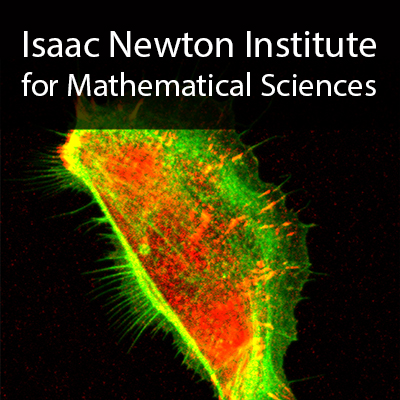Self-organizatin of the actin cytoskeleton
Duration: 1 hour 10 mins
Share this media item:
Embed this media item:
Embed this media item:
About this item

| Description: |
Bershadsky, A
Tuesday 14th July 2015, 14:30 - 15:30 |
|---|
| Created: | 2015-07-15 19:09 |
|---|---|
| Collection: | Coupling Geometric PDEs with Physics for Cell Morphology, Motility and Pattern Formation |
| Publisher: | Isaac Newton Institute |
| Copyright: | Bershadsky, A |
| Language: | eng (English) |
| Abstract: | We discuss here some aspects of local and global self-organization of the actomyosin cytoskeleton in the fibroblast-type cells. (1) Locally, the cytoplasm comprises a multi-nodal network formed by small asters of actin filaments nucleated by DAAM1 formin and stabilized by the actin crosslinking protein filamin A. The asters are connected with each other by myosin II, so that the entire system forms a contractile network responsible for the maintenance of the cell shape. (2) Observations of the assembly of myosin-II filament arrays by structured illumination microscopy (SIM) revealed myosin-II “stacks” formed by alignment in register of the myosin-II bipolar filaments associated with actin fibers. In the cells spread over the planar substrate, the numerous myosin stacks apparently form the links between neighboring actin filament bundles (stress-fibers or arcs), maintaining the organization of the actin cytoskeleton. (3) Globally, upon spreading on planar substrate s, cells develop chiral arrays of actin filament bundles. In fibroblasts confined to the circular adhesive islands, a radially symmetrical system of actin bundles, consisting of alpha-actinin-enriched radial fibers (RFs) and myosin-IIA-enriched transverse fibers (TFs), evolved spontaneously into the chiral system as a result of the unidirectional tilting of all RFs accompanied by a tangential shift in the retrograde movement of TFs. The handedness of the chiral pattern is regulated by alpha-actinin-1. Experimental observations together with computational modeling, demonstrated how the interactions between RFs nucleated by formins and contractile TFs could result in the transition of the actin pattern from radial to chiral, left-right asymmetric organization. Thus, actin cytoskeleton self-organization provides built-in machinery that potentially allows cells to develop left-right asymmetry. Such actin-based mechanism could underlie the development of left-right asymmetry in tissues and embryos. Related Links:
http://labs.mbi.nus.edu.sg/abcd/index.html - Bershadsky's lab at Mechanobiology Institute, Singapore |
|---|---|
Available Formats
| Format | Quality | Bitrate | Size | |||
|---|---|---|---|---|---|---|
| MPEG-4 Video | 640x360 | 1.96 Mbits/sec | 1.01 GB | View | Download | |
| WebM | 640x360 | 1.15 Mbits/sec | 608.49 MB | View | Download | |
| iPod Video | 480x270 | 526.36 kbits/sec | 269.86 MB | View | Download | |
| MP3 | 44100 Hz | 252.74 kbits/sec | 129.58 MB | Listen | Download | |
| Auto * | (Allows browser to choose a format it supports) | |||||

